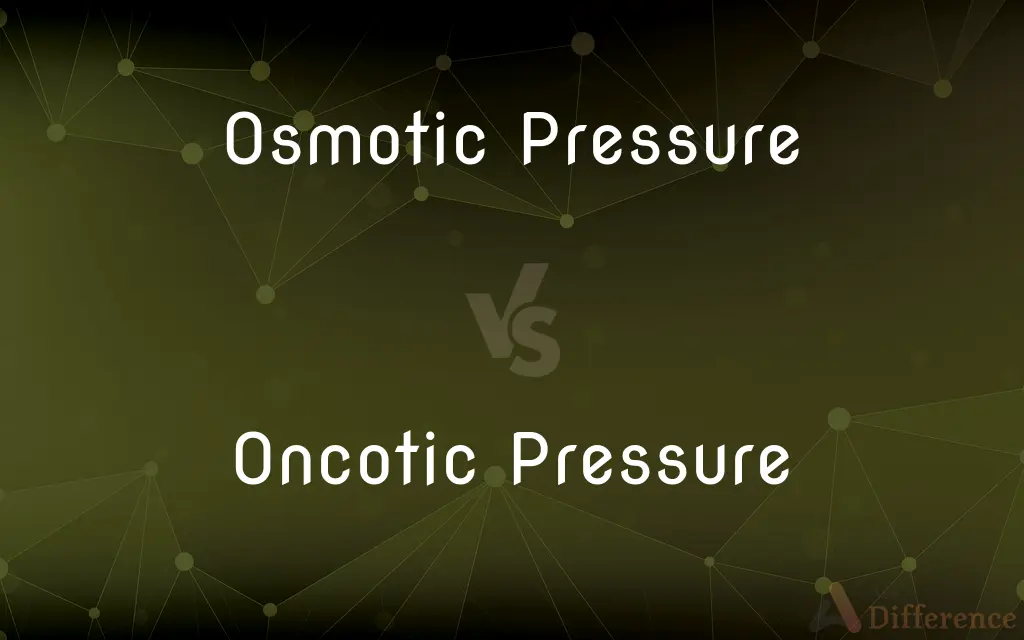Osmotic Pressure vs. Oncotic Pressure — What's the Difference?
By Tayyaba Rehman — Published on November 23, 2023
Osmotic Pressure is the pressure caused by differences in solute concentration across a semipermeable membrane. Oncotic Pressure, a subset of osmotic pressure, specifically refers to the pressure exerted by proteins in blood plasma.

Difference Between Osmotic Pressure and Oncotic Pressure
Table of Contents
ADVERTISEMENT
Key Differences
Osmotic Pressure and Oncotic Pressure are both terms used in the field of biology and medicine to describe pressures exerted by solutions. However, their sources and specific implications vary.
Osmotic Pressure arises due to the differences in solute concentration on either side of a semipermeable membrane. It's the pressure required to stop the movement of water across the membrane. Oncotic Pressure, on the other hand, specifically deals with the osmotic pressure generated by proteins, notably in the blood plasma.
Water molecules tend to move from areas of low solute concentration to high concentration, a phenomenon known as osmosis. Osmotic Pressure quantifies this force of movement. Whereas, Oncotic Pressure highlights the role of proteins, especially albumin, in pulling water into the circulatory system.
Understanding Osmotic Pressure is fundamental in various biological processes, including nutrient absorption and cellular function. Oncotic Pressure is crucial in maintaining fluid balance in the circulatory system and preventing edema.
Both pressures play a vital role in keeping homeostasis in organisms. While Osmotic Pressure is a broader concept, Oncotic Pressure offers a more specific look at the influence of proteins in osmotic activity.
ADVERTISEMENT
Comparison Chart
Definition
Pressure from solute concentration differences
Pressure from plasma proteins
Source
Solute concentration in solution
Plasma proteins, mainly albumin
Role
Maintains cellular fluid balance
Maintains blood plasma fluid balance
Implications
Found in all cells
Primarily in circulatory system
Significance
Fundamental in biology and cellular processes
Essential for blood fluid balance and preventing edema
Compare with Definitions
Osmotic Pressure
Resultant force from unequal solute concentrations.
High sugar content outside a cell can increase Osmotic Pressure.
Oncotic Pressure
Subset of osmotic pressure due to proteins.
Decreased albumin can reduce Oncotic Pressure.
Osmotic Pressure
The force driving osmosis.
Salt solutions can create significant Osmotic Pressure.
Oncotic Pressure
Counteracts hydrostatic pressure in blood vessels.
Oncotic Pressure helps retain fluids within the circulatory system.
Osmotic Pressure
Pressure needed to stop osmosis.
To prevent water movement, one must apply an opposing Osmotic Pressure.
Oncotic Pressure
Mainly due to albumin in blood.
Oncotic Pressure can be assessed to gauge albumin levels.
Osmotic Pressure
Fundamental in cellular fluid dynamics.
Cells regulate their Osmotic Pressure to maintain structure and function.
Oncotic Pressure
Pressure from plasma proteins.
Oncotic Pressure draws fluid into the blood vessels.
Osmotic Pressure
Pressure due to solute concentration gradients.
Osmotic Pressure causes water to move into the cell.
Oncotic Pressure
Vital for blood fluid balance.
Adequate Oncotic Pressure prevents tissue swelling.
Common Curiosities
What's the primary protein influencing Oncotic Pressure?
Albumin.
Can Osmotic Pressure be observed in all cells?
Yes, it's a fundamental aspect of cellular fluid balance.
Is Oncotic Pressure a type of Osmotic Pressure?
Yes, it's a subset of osmotic pressure specifically due to proteins.
What causes Osmotic Pressure?
Differences in solute concentration across a semipermeable membrane.
What happens if Osmotic Pressure inside a cell is too high?
The cell can burst due to excessive water influx.
How does drinking saline solutions affect Osmotic Pressure?
It can increase the osmotic pressure in the bloodstream, drawing water out of cells.
What instruments measure Osmotic Pressure?
Osmometers are commonly used.
Why is Oncotic Pressure essential in the circulatory system?
It helps maintain fluid balance and prevents edema.
Is Osmotic Pressure only about water movement?
It primarily concerns water, but osmosis can involve other solvents in specific scenarios.
Can a decrease in Oncotic Pressure lead to swelling?
Yes, reduced Oncotic Pressure can lead to edema, or tissue swelling.
How is Oncotic Pressure affected by liver diseases?
Liver diseases can reduce albumin production, thus decreasing oncotic pressure.
Why is Oncotic Pressure also called colloid osmotic pressure?
Because it's due to colloidal particles, primarily proteins, in plasma.
Is the concept of Osmotic Pressure exclusive to biology?
No, it's a fundamental principle found in various scientific domains, including chemistry.
Are there medical conditions related to altered Oncotic Pressure?
Yes, conditions like hypoalbuminemia, where there's low albumin, can alter oncotic pressure.
Can Oncotic Pressure influence blood pressure?
Indirectly, yes. Changes in blood volume due to oncotic pressure can affect blood pressure.
Share Your Discovery

Previous Comparison
Invoice vs. Cash Memo
Next Comparison
Top Control Dishwashers vs. Front Control DishwashersAuthor Spotlight
Written by
Tayyaba RehmanTayyaba Rehman is a distinguished writer, currently serving as a primary contributor to askdifference.com. As a researcher in semantics and etymology, Tayyaba's passion for the complexity of languages and their distinctions has found a perfect home on the platform. Tayyaba delves into the intricacies of language, distinguishing between commonly confused words and phrases, thereby providing clarity for readers worldwide.
















































